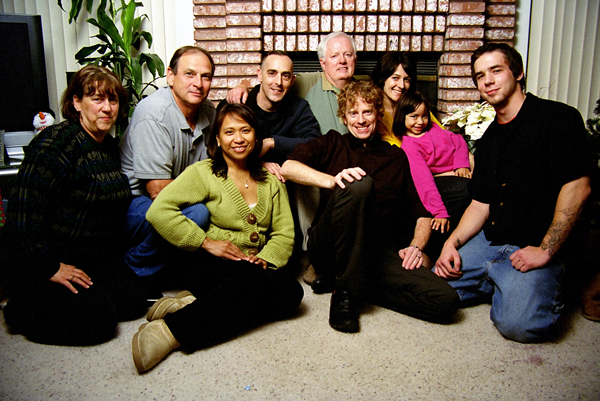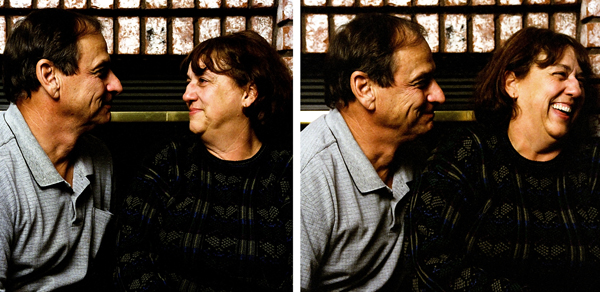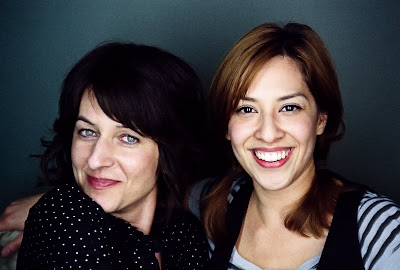
For the past twelve or thirteen years, it's been a tradition of mine to spend Christmas night with my friend Chris and his family. Early versions of the gathering usually culminated in round after round of Sambuca shots until yours truly was reduced to an incoherent mess, heaving into a mixing bowl, desperately trying to pass out on the couch. Good times.
Chris' family is great: lots of wonderful faces, stories, laughs, love, etc. As far as extended families go, you couldn't ask for more. I live near to Chris and his wife Bozena, so I'm always photographing them but for the past couple years I'd been wanting to find a way to work my camera into one of the gatherings with his whole family. This last Christmas (2008) I got my chance.

Art (Chris' dad) had his circa 1980s Minolta SLR out for the occasion with a flash on the hotshoe. It was a sweet rig for its time: auto everything with a TTL flash so all you have to do is point and shoot. In the couple times I've held the thing, it has mystified me. I can normally pick up a camera and figure out how to turn off the auto features and set the shutter speed, aperture, and ISO manually. But, the design of the camera is very 1980s, with plenty of square silver buttons that did nothing I wanted them to in the few minutes I poked at them. In my defense, Art had the thing set up for his way of shooting and I didn't want to screw up his settings and not be able to put them back, so I left well enough alone and stuck to the camera I brought (a Yashica Electro 35 GT).
At one point, later in the evening after dinner, Art asked me if I'd take a family portrait in the living room and handed me his Minolta. I sorta panicked but figured I'd fight through...I'd just leave it on auto everything mode and blast away with the flash on top...perhaps bounce it off the ceiling. Yeah, that will look sharp. Let the camera do the work! As I familiarized myself with the camera for a minute will everything convened in the living room, joking and working themselves into 'picture mode,' the camera started to malfunction. The flash wouldn't fire. I tried again. Nothing. I gave it to Chris (who was standing nearby). Still nothing. Art was called over and he couldn't get it to fire, either.
This was my moment! I had a small lighting kit in the trunk of my girlfriend's car...not something I carry with me everywhere, but she and I were leaving town to go
 ride out the last few days of the year in Utah with my mom and step-dad, and I wanted some gear with me for whatever might come up. I'm glad I had it because this was my chance to do a couple things: Get some pictures of this great family, and work quickly in a small strobe scenario to get the results I wanted. First I had to determine what it was I wanted...as I dashed out into the blistering cold high desert night to grab my gear from the car.
ride out the last few days of the year in Utah with my mom and step-dad, and I wanted some gear with me for whatever might come up. I'm glad I had it because this was my chance to do a couple things: Get some pictures of this great family, and work quickly in a small strobe scenario to get the results I wanted. First I had to determine what it was I wanted...as I dashed out into the blistering cold high desert night to grab my gear from the car.I should probably mention that all I had with me was a 35mm film camera: I'd brought with me my trusty Canon AE-1 Program—given to me on my birthday by my late father in 2000—and I had a ZipLock bag full of expired Kodak Gold 100 film. Lighting-wise, I had a bag full of Sunpak 333 and 383 flashes, a flash meter and a set of Pocket Wizards...plus stands and umbrellas.
That's what I had to work with, so I knew I had to keep my lighting pretty general. I wasn't going to be able to chimp the LCD and fine tune a multiple light set up like I can with my digital SLR. I figured I'd stick with one light to keep things moving quickly, plus there were a lot of people in Art's living room, so I wanted to keep the amount of gear to a minimum. I knew the ambient light in the living room was not going to factor into this shot because it was far too dim and I was working at ISO 100.
 In order to get any ambient light into the shot I would have needed very long shutter speeds, which would not have worked in this situation. Again, trying to work quickly, plus there was a six-year-old in the group and getting her to sit still for a one or two second exposure wasn't going to happen. Because my ambient was going to be so low compared to the strobe, I knew the shadows were going to go black...nice and dramatic but, thanks to the 1/4 CTO gel I put on my Sunpak 333, I was able to achieve a warmth that brought a coziness to the drama of the large lighting ratio. I put the light up high and shot it through a 42 inch shoot through umbrella, which went a long way to mimic the directional, semi-soft light source you might find in a living room. This helped the shots look natural to the setting and everyone was really happy with them. They made a great present to Art on his birthday a couple weeks after Christmas.
In order to get any ambient light into the shot I would have needed very long shutter speeds, which would not have worked in this situation. Again, trying to work quickly, plus there was a six-year-old in the group and getting her to sit still for a one or two second exposure wasn't going to happen. Because my ambient was going to be so low compared to the strobe, I knew the shadows were going to go black...nice and dramatic but, thanks to the 1/4 CTO gel I put on my Sunpak 333, I was able to achieve a warmth that brought a coziness to the drama of the large lighting ratio. I put the light up high and shot it through a 42 inch shoot through umbrella, which went a long way to mimic the directional, semi-soft light source you might find in a living room. This helped the shots look natural to the setting and everyone was really happy with them. They made a great present to Art on his birthday a couple weeks after Christmas.I'll gladly call that a successful shoot.
Technical details:
Camera: Canon AE-1 Program
Lens: Vivitar Series 1 28-90mm f/2.8-3.5
Film: Kodak Gold 100 (expired 2003)
Strobe: Sunpak 333 w/ 1/4 CTO gel
Modifier: 42 inch shoot through umbrella
Trigger: Pocket Wizard Plus
Camera settings: 1/60, f/4 and f/5.6, ISO 100
Scanner: Minolta Scan Dual II with VueScan
What would I have done differently?
I was working very quickly, trying to joke with everyone and keep the energy up while I set up. I normally overexpose color neg film by 2/3 of a stop, which I forgot to do here. I should have shot that Kodak 100 at ISO 64. I was able to lighten the skin tones and put them where they need to be with Photoshop, but when you underexpose color neg film the grain gets more pronounced...even at ISO 100.



